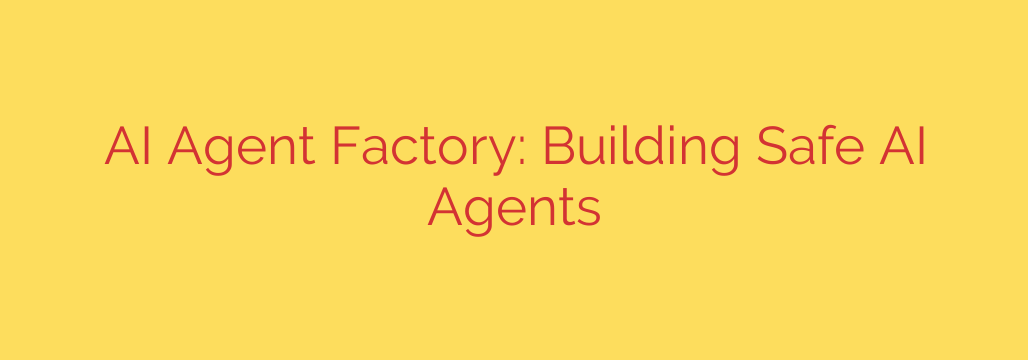
Building Secure AI Agents: A Framework for Safety and Scalability
Autonomous AI agents are poised to revolutionize how we work, promising to handle complex tasks, manage workflows, and dramatically increase efficiency. From booking travel to analyzing data and executing code, these agents can act on our behalf with unprecedented independence. However, this very autonomy introduces a new and critical class of security vulnerabilities that organizations must address proactively.
As we move from simple chatbots to powerful, action-oriented agents, the stakes become significantly higher. An insecure agent isn’t just a privacy risk; it can become a vector for data breaches, financial loss, and operational chaos. Building these systems requires a security-first mindset, moving beyond ad-hoc development to a structured, scalable, and safe framework.
Understanding the Core Security Risks of AI Agents
Before building a solution, it’s essential to understand the unique threats that autonomous AI presents. These go far beyond the risks associated with traditional software.
Prompt Injection: This is one of the most significant threats. A malicious actor can craft an input that tricks the AI into ignoring its original instructions and executing a harmful command instead. For an agent with access to internal systems, a successful prompt injection could mean deleting files, exfiltrating sensitive data, or sending unauthorized communications.
Unauthorized Tool and API Access: AI agents rely on tools and APIs to interact with the digital world. If an agent’s access is not strictly controlled, it could be manipulated into using a tool for a malicious purpose. For example, an agent designed to send meeting invites could potentially be tricked into using the same email tool to spam clients or access private calendars.
Data Leakage and Privacy Breaches: Agents often need access to sensitive information to perform their tasks. Without proper safeguards, they can inadvertently expose confidential company data, customer PII (personally identifiable information), or proprietary code in their responses or actions.
Denial of Service (DoS): Malicious actors could overwhelm an AI agent with complex, resource-intensive tasks, causing it to crash or become unavailable. This can disrupt critical business operations that rely on the agent’s functionality.
A Blueprint for Secure AI Agent Development
To mitigate these risks, developers need a systematic approach—a virtual “factory” for producing AI agents with safety built-in from the ground up. This framework is based on several key principles.
1. Operate Within a Sandboxed Environment
An AI agent should never operate with unrestricted access to a company’s entire digital infrastructure. Instead, each agent must run within a secure, isolated sandbox. This containerized environment limits the agent’s reach, ensuring that even if it is compromised, the potential damage is contained. It cannot access files, networks, or processes outside of its designated workspace.
2. Enforce the Principle of Least Privilege
Every agent and the tools it uses must adhere to the principle of least privilege. This means it should only be granted the absolute minimum permissions required to perform its specific function. An agent tasked with analyzing sales data, for example, should have read-only access to a specific database and no ability to write, delete, or access HR records. Permissions should be granular and regularly audited.
3. Implement Robust Monitoring and Logging
You cannot secure what you cannot see. Comprehensive logging is non-negotiable. Every action taken by an AI agent—every API call made, every file accessed, and every command executed—must be logged and monitored in real-time. This creates a clear audit trail that is invaluable for detecting anomalous behavior, investigating security incidents, and ensuring compliance.
4. Require Human-in-the-Loop (HITL) for Critical Actions
For high-stakes or irreversible actions, full autonomy is a liability. A human-in-the-loop (HITL) system is essential. Before executing a critical task, such as deploying code to production, deleting a database, or sending a mass email, the agent must be required to seek and receive explicit approval from a human user. This provides a crucial failsafe against both malicious attacks and unintentional errors.
Actionable Best Practices for Enhancing Agent Security
Whether you are building or deploying AI agents, integrating the following practices can significantly strengthen your security posture:
- Start with Read-Only Permissions: When deploying a new agent, begin with read-only access. Gradually grant more permissions as you verify its performance and safety in a controlled setting.
- Implement Multi-Step Confirmation: For sensitive operations, program the agent to ask clarifying questions or require a multi-step confirmation from the user before proceeding.
- Secure API Endpoints: Ensure that any APIs the agent interacts with are secured with robust authentication and authorization protocols. Use dedicated API keys for each agent to track usage and revoke access if needed.
- Assume a Zero-Trust Model: Treat every request and action from an agent as potentially untrustworthy until it is verified. Validate inputs and outputs rigorously to prevent manipulation.
- Regularly Audit and Rotate Credentials: The credentials and API keys used by agents should be audited regularly and rotated periodically to minimize the risk of a compromised key being used long-term.
The era of autonomous AI agents is here, and their potential is immense. However, realizing this potential safely depends on our ability to build security into the very foundation of these systems. By adopting a structured, defense-in-depth framework, we can unlock the power of AI automation while protecting our most critical assets.
Source: https://azure.microsoft.com/en-us/blog/agent-factory-creating-a-blueprint-for-safe-and-secure-ai-agents/








